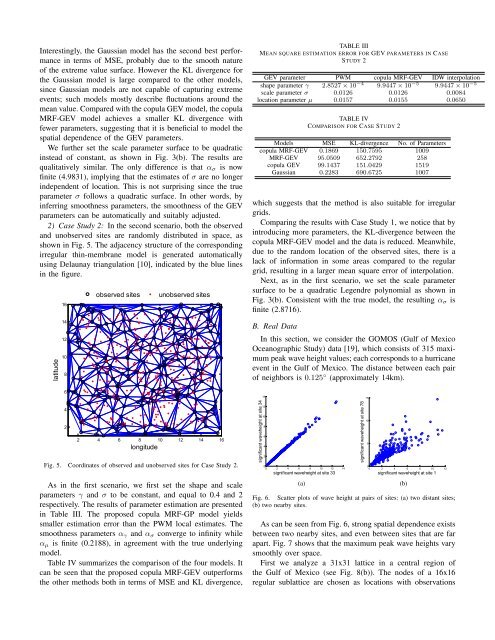Dependent spatial extremes
Dependent spatial extremes
Dependent spatial extremes
You also want an ePaper? Increase the reach of your titles
YUMPU automatically turns print PDFs into web optimized ePapers that Google loves.
Interestingly, the Gaussian model has the second best performance<br />
in terms of MSE, probably due to the smooth nature<br />
of the extreme value surface. However the KL divergence for<br />
the Gaussian model is large compared to the other models,<br />
since Gaussian models are not capable of capturing extreme<br />
events; such models mostly describe fluctuations around the<br />
mean value. Compared with the copula GEV model, the copula<br />
MRF-GEV model achieves a smaller KL divergence with<br />
fewer parameters, suggesting that it is beneficial to model the<br />
<strong>spatial</strong> dependence of the GEV parameters.<br />
We further set the scale parameter surface to be quadratic<br />
instead of constant, as shown in Fig. 3(b). The results are<br />
qualitatively similar. The only difference is that α σ is now<br />
finite (4.9831), implying that the estimates of σ are no longer<br />
independent of location. This is not surprising since the true<br />
parameter σ follows a quadratic surface. In other words, by<br />
inferring smoothness parameters, the smoothness of the GEV<br />
parameters can be automatically and suitably adjusted.<br />
2) Case Study 2: In the second scenario, both the observed<br />
and unobserved sites are randomly distributed in space, as<br />
shown in Fig. 5. The adjacency structure of the corresponding<br />
irregular thin-membrane model is generated automatically<br />
using Delaunay triangulation [10], indicated by the blue lines<br />
in the figure.<br />
latitude<br />
16<br />
14<br />
12<br />
10<br />
8<br />
observed sites<br />
unobserved sites<br />
TABLE III<br />
MEAN SQUARE ESTIMATION ERROR FOR GEV PARAMETERS IN CASE<br />
STUDY 2<br />
GEV parameter PWM copula MRF-GEV IDW interpolation<br />
shape parameter γ 2.8527 × 10 −4 9.9447 × 10 −5 9.9447 × 10 −5<br />
scale parameter σ 0.0126 0.0126 0.0084<br />
location parameter µ 0.0157 0.0155 0.0650<br />
TABLE IV<br />
COMPARISON FOR CASE STUDY 2<br />
Models MSE KL-divergence No. of Parameters<br />
copula MRF-GEV 0.1869 150.7595 1009<br />
MRF-GEV 95.0509 652.2792 258<br />
copula GEV 99.1437 151.0429 1519<br />
Gaussian 0.2283 690.6725 1007<br />
which suggests that the method is also suitable for irregular<br />
grids.<br />
Comparing the results with Case Study 1, we notice that by<br />
introducing more parameters, the KL-divergence between the<br />
copula MRF-GEV model and the data is reduced. Meanwhile,<br />
due to the random location of the observed sites, there is a<br />
lack of information in some areas compared to the regular<br />
grid, resulting in a larger mean square error of interpolation.<br />
Next, as in the first scenario, we set the scale parameter<br />
surface to be a quadratic Legendre polynomial as shown in<br />
Fig. 3(b). Consistent with the true model, the resulting α σ is<br />
finite (2.8716).<br />
B. Real Data<br />
In this section, we consider the GOMOS (Gulf of Mexico<br />
Oceanographic Study) data [19], which consists of 315 maximum<br />
peak wave height values; each corresponds to a hurricane<br />
event in the Gulf of Mexico. The distance between each pair<br />
of neighbors is 0.125 ◦ (approximately 14km).<br />
6<br />
14<br />
15<br />
4<br />
2<br />
2 4 6 8 10 12 14 16<br />
longitude<br />
Fig. 5. Coordinates of observed and unobserved sites for Case Study 2.<br />
As in the first scenario, we first set the shape and scale<br />
parameters γ and σ to be constant, and equal to 0.4 and 2<br />
respectively. The results of parameter estimation are presented<br />
in Table III. The proposed copula MRF-GP model yields<br />
smaller estimation error than the PWM local estimates. The<br />
smoothness parameters α γ and α σ converge to infinity while<br />
α µ is finite (0.2188), in agreement with the true underlying<br />
model.<br />
Table IV summarizes the comparison of the four models. It<br />
can be seen that the proposed copula MRF-GEV outperforms<br />
the other methods both in terms of MSE and KL divergence,<br />
significant waveheight at site 34<br />
12<br />
10<br />
8<br />
6<br />
4<br />
2<br />
0<br />
0 2 4 6 8 10 12 14<br />
significant waveheight at site 33<br />
(a)<br />
significant waveheight at site 78<br />
10<br />
5<br />
0<br />
0 2 4 6 8 10 12<br />
significant waveheight at site 1<br />
Fig. 6. Scatter plots of wave height at pairs of sites: (a) two distant sites;<br />
(b) two nearby sites.<br />
As can be seen from Fig. 6, strong <strong>spatial</strong> dependence exists<br />
between two nearby sites, and even between sites that are far<br />
apart. Fig. 7 shows that the maximum peak wave heights vary<br />
smoothly over space.<br />
First we analyze a 31x31 lattice in a central region of<br />
the Gulf of Mexico (see Fig. 8(b)). The nodes of a 16x16<br />
regular sublattice are chosen as locations with observations<br />
(b)
















